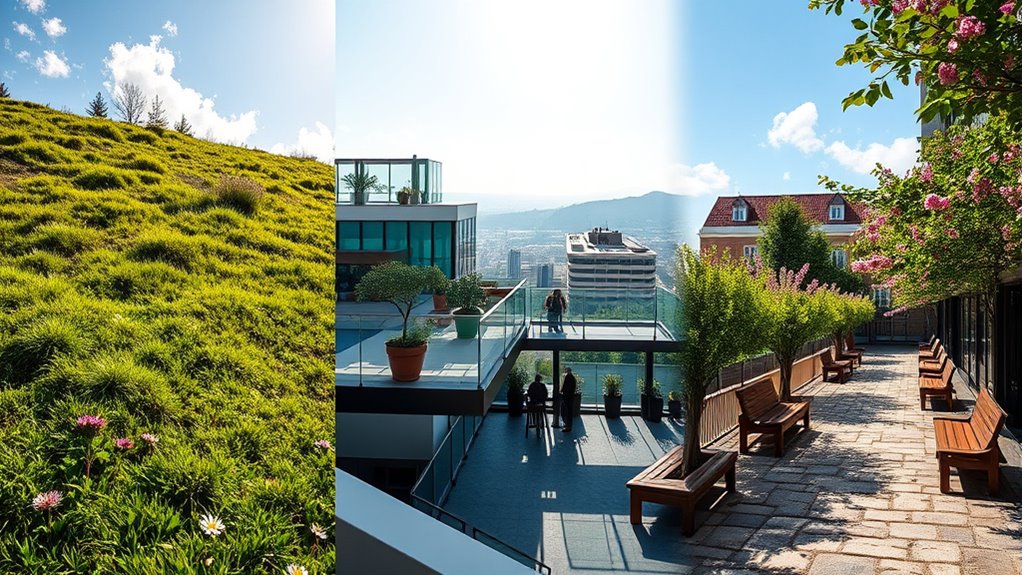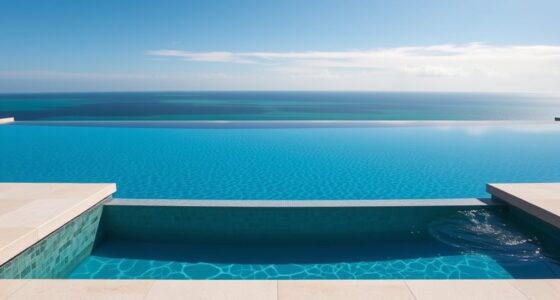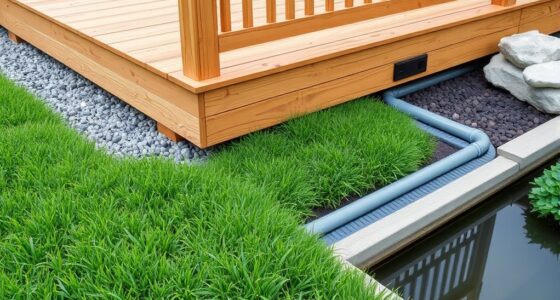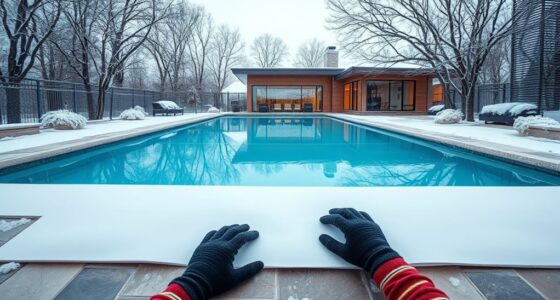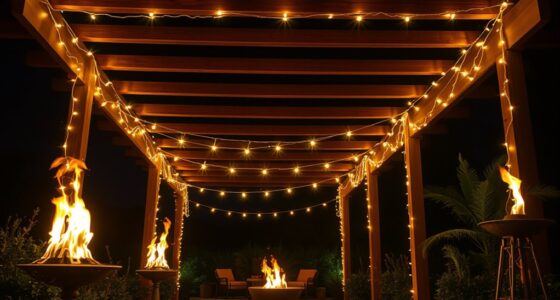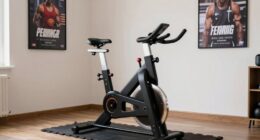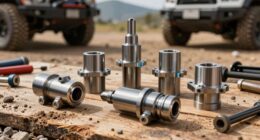When choosing between hillside, rooftop, or courtyard sites, consider your natural landscape, sunlight needs, privacy, and maintenance. Hillsides offer scenic views but need careful erosion control and safety measures. Rooftops are great for maximizing space and views but require insulation and structural support. Courtyards are ideal for privacy and outdoor enjoyment but depend on accessibility and surrounding environment. To make the best choice, weigh these factors—more insights await to help you decide wisely.
Key Takeaways
- Assess natural land contours and views to maximize scenic impact and site integration for hillside, rooftop, or courtyard locations.
- Consider sunlight exposure, climate, and wind patterns to ensure comfort and structural support in each site type.
- Evaluate accessibility, privacy needs, and intended use to select the most functional and enjoyable space.
- Analyze maintenance requirements and durability issues relevant to each site to ensure long-term safety and ease of upkeep.
- Match site features with lifestyle goals and aesthetic preferences for visual harmony and environmental integration.
Assessing the Natural Landscape and Topography

When evaluating a potential site, examining the natural landscape and topography is essential. You need to observe how the land slopes and contours, as these can affect drainage and stability. Steep slopes might provide scenic views but can also lead to erosion or difficulty in construction. Flat areas are easier to build on but might require additional grading or retaining walls. Consider existing features like rocks, trees, or water bodies, which can influence your design choices. By understanding the natural layout, you’ll identify the best spots for your project, ensuring safety and longevity. Recognizing how the land naturally behaves helps you plan effectively and avoid costly surprises later on. Additionally, understanding the terrain modifications involved can help you anticipate the effort and resources needed for development. This step lays the foundation for a successful site selection process.
Evaluating Sunlight and Climate Conditions
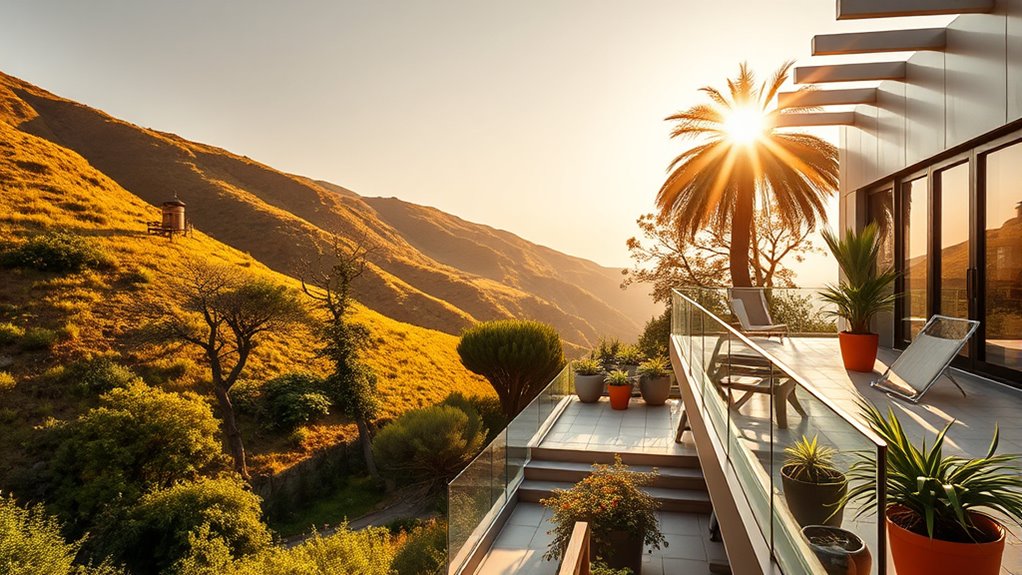
After analyzing the natural features of your site, it’s time to contemplate how sunlight and climate will impact your project. Observe the sun’s path throughout the year to determine which areas receive the most sunlight and when shade occurs. Consider local climate patterns—are summers hot and dry or mild and humid? This will influence your choice of materials, shading solutions, and plantings. On a hillside, sunlight exposure varies with slope orientation, affecting heating and cooling needs. On rooftops, wind and sun exposure can be intense, requiring proper insulation. Courtyards might offer shelter from wind but need careful planning for sunlight access. Understanding these factors helps you optimize comfort, energy efficiency, and sustainability for your site. Additionally, incorporating natural materials can enhance thermal regulation and blend seamlessly with the environment.
Considering Accessibility and Privacy Factors

You should think about how easy it is to reach the site and whether it offers enough privacy for your needs. A convenient location saves time and effort, while seclusion helps maintain your privacy and comfort. Balancing accessibility with privacy guarantees your site fits your lifestyle and goals. Additionally, considering privacy policies and user consent ensures your data is protected and your preferences are respected.
Ease of Access
Have you considered how easily accessible your site is to visitors while also safeguarding their privacy? Ease of access impacts both convenience and security. If visitors struggle to reach the site or feel exposed, it may hinder usage or cause discomfort. Think about pathways, signage, and proximity to main routes. Here’s a quick comparison:
| Aspect | Consideration |
|---|---|
| Pathway Accessibility | Wide, smooth paths for all mobility levels |
| Privacy | Shielded entry points from public view |
| Transportation | Close to parking or transit options |
| Security Measures | Lighting and surveillance for safety |
| Visibility | Clear sightlines for easy navigation |
Balancing these factors ensures your site is welcoming yet private, enhancing overall experience. Additionally, ensuring site security measures are in place can help protect visitor privacy and safety.
Level of Seclusion
Balancing ease of access with privacy becomes more complex when considering the site’s level of seclusion. If you want a space that offers peace and privacy, you’ll need to weigh how accessible it is. A secluded courtyard or rooftop might provide the quiet you crave, but they could be harder for guests or service providers to reach. Conversely, hillside sites often offer natural privacy but may require more effort to access safely. Think about your daily routines and how often you’ll need to enter or leave the space. Consider nearby neighbors or public visibility, which can compromise your sense of seclusion. Choosing a site with appropriate access points can help maintain your desired level of privacy while ensuring convenience. Ultimately, finding the right balance depends on how much privacy you need versus how easily you want to get in and out.
Analyzing Maintenance and Upkeep Requirements
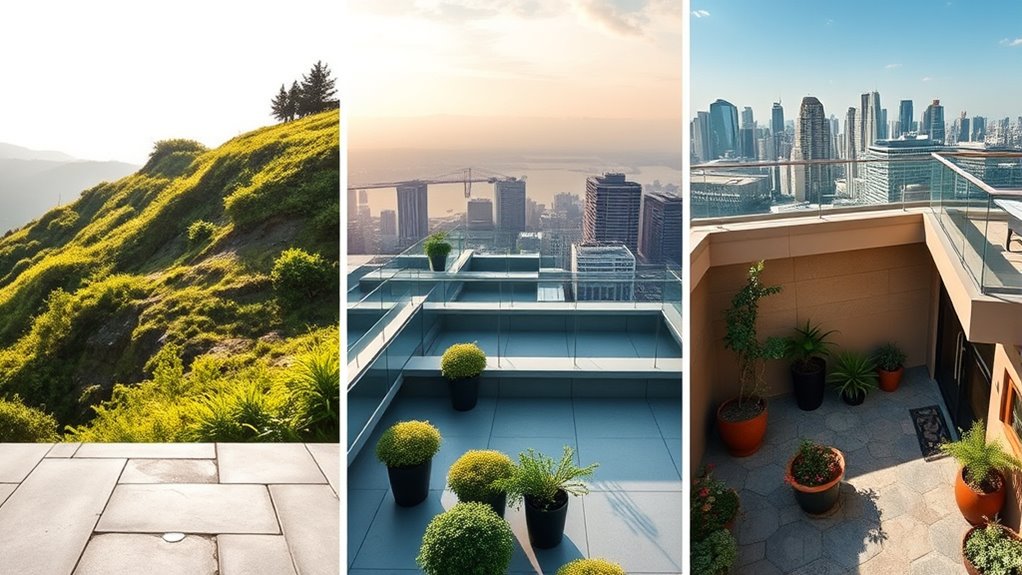
When evaluating a site, you need to contemplate how accessible and easy it is to clean regularly. Weather conditions can also impact how quickly the property wears down and requires repairs. Understanding these factors helps you plan for ongoing maintenance costs and efforts. Incorporating vertical storage solutions can help maximize space and simplify upkeep in outdoor areas.
Accessibility and Cleaning Needs
Accessibility and cleaning needs are critical factors to contemplate because they directly impact the ongoing maintenance and overall upkeep of your site. If your location is hard to reach, routine tasks like watering, pruning, or cleaning become more labor-intensive and costly. Rooftop gardens, for instance, may require special equipment or lifts, increasing effort and expense. Courtyards and hillside sites might be easier to access but could face challenges with debris buildup or soil erosion that demand regular attention. Consider how easily you and maintenance staff can access the area without disrupting daily activities. Also, think about cleaning requirements—are there surfaces that collect dust or debris quickly? Choosing a site with straightforward access and manageable cleaning needs simplifies maintenance, saving you time and money long-term. Additionally, understanding the local building codes and permits can influence maintenance procedures and accessibility requirements over time.
Weather-Related Wear and Tear
Weather conditions can considerably influence how much maintenance your site requires over time. On a hillside, heavy rain and erosion can weaken soil stability, leading to frequent repairs or reinforcement. Rooftop sites face exposure to harsh sun, wind, and snow, which can cause material degradation, cracking, or corrosion. Courtyards, especially in humid or rainy climates, may develop mold, moss, or water damage that demands regular cleaning and waterproofing. Wind-driven debris can also accelerate wear on all sites. To keep maintenance manageable, consider the local climate’s severity and how it interacts with your chosen location. Regular inspections, protective coatings, and durable materials can help mitigate weather-related damage, prolonging your site’s lifespan and reducing long-term upkeep costs. Additionally, understanding regional weather patterns can help you better anticipate and plan for potential wear and tear.
Maximizing Views and Aesthetic Appeal

Choosing the right site is essential to maximize both views and aesthetic appeal. If you want stunning vistas, select a location that offers unobstructed sightlines, like a hillside or rooftop. Position your structure to capture the best natural scenery, framing views with windows or open spaces. Use materials and design elements that complement the environment, enhancing visual harmony. Incorporate landscaping or decorative features that highlight the setting’s natural beauty. Keep sightlines clear of clutter or unnecessary obstructions. Consider the surrounding architecture and landscape to create a cohesive, attractive appearance. Understanding how visual harmony and environment integration influence aesthetic appeal can help you make more informed design choices. By thoughtfully choosing your site and orienting your design, you’ll notably boost the visual impact and overall charm of your space, making it a more inviting and picturesque environment.
Planning for Safety and Structural Support

After selecting a site with great views and aesthetic appeal, it’s important to focus on safety and structural support to guarantee your space remains secure and durable. Assess the soil stability and drainage capabilities to prevent erosion or flooding, especially on hillside sites. Consult engineers or structural experts to determine load-bearing capacity and reinforcement needs, ensuring your foundation can handle weight and environmental stress. Consider wind exposure, seismic activity, and other natural risks, implementing appropriate protections like reinforcement or anchoring systems. Regular inspections and maintenance are key to catching issues early. Additionally, understanding soil stability and drainage is essential for preventing future structural issues. By prioritizing these safety measures, you create a resilient structure that withstands environmental challenges, providing peace of mind and ensuring your investment remains sound over time.
Aligning the Site With Your Lifestyle and Usage Goals
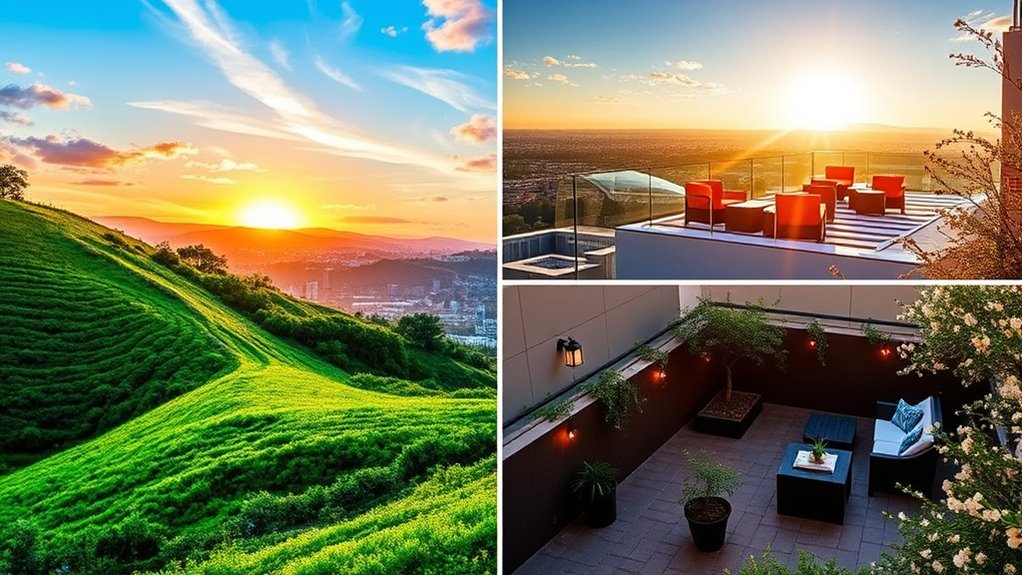
To make certain your site meets your needs, it’s essential to think about how its location and features align with your daily routines and long-term goals. Consider how often you’ll use the space and for what purposes—relaxing, entertaining, gardening, or working. If you enjoy hosting gatherings, a courtyard or rooftop might suit your social lifestyle. If privacy matters most, a hillside site could provide seclusion. Think about accessibility and maintenance—will you want easy access or more remote tranquility? Also, evaluate the climate and sunlight exposure to ensure comfort year-round. Aligning your site with your lifestyle helps you create a functional, enjoyable space that enhances your daily life and future plans, making your investment more satisfying and sustainable.
Frequently Asked Questions
What Are the Cost Differences Between Hillside, Rooftop, and Courtyard Sites?
Hillside sites usually cost more due to excavation and foundation work needed to stabilize slopes. Rooftop locations tend to be moderate in price but can increase expenses with structural reinforcements and permits. Courtyard setups are often the most budget-friendly, especially in existing spaces, but costs can rise if landscaping or extensive modifications are required. Your choice depends on your budget, site accessibility, and the project’s specific needs.
How Do Local Building Codes Impact Site Selection Options?
Local building codes substantially influence your site selection by dictating safety standards, zoning restrictions, and permitted structures. You need to make certain your chosen site complies with height, setback, and load-bearing requirements. Failing to meet these codes can lead to costly delays or modifications. Consequently, you should consult local regulations early in the planning process, aligning your site choice with legal standards to avoid future complications and guarantee smooth project approval.
What Are the Best Plants and Landscaping Ideas for Each Site Type?
Choosing the right plants is like selecting a wardrobe for each season. For hillside sites, opt for drought-tolerant succulents and native grasses that prevent erosion. Rooftops thrive with lightweight, sun-loving plants like lavender, sedum, and ornamental grasses. Courtyards suit shade-loving shrubs, flowering perennials, and small trees that create privacy and shade. Use container gardens or raised beds to maximize space and guarantee proper drainage across all sites.
How Can I Incorporate Sustainable Design Elements Into My Site Choice?
You can incorporate sustainable design by selecting native plants that thrive naturally in your site, reducing water and maintenance needs. Use permeable paving to improve drainage and minimize runoff, and install solar lighting or solar panels to harness renewable energy. Incorporate rain gardens or greywater systems to manage water efficiently. By designing with these elements, you create an eco-friendly space that benefits both the environment and your long-term sustainability goals.
What Are Common Challenges Faced During Construction on Each Site?
You face towering challenges during construction on each site. Hillsides threaten with landslides and unstable terrain, making excavation feel like battling nature itself. Rooftops confront you with weight limits and structural reinforcements, turning every step into a balancing act. Courtyards struggle with space constraints and underground utilities, transforming simple tasks into complex puzzles. Every site demands resilience, ingenuity, and a fierce problem-solving spirit to turn ambitious visions into reality.
Conclusion
Ultimately, choosing the right site is about finding the perfect fit for your lifestyle and dreams. Whether it’s a hillside, rooftop, or courtyard, each offers unique advantages and challenges. Trust your instincts and weigh all factors carefully—remember, the right site can turn your vision into a reality that blossoms like a well-tended garden. When you strike the right balance, you’ll have a space that feels like it was made just for you.
